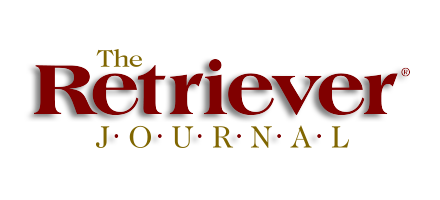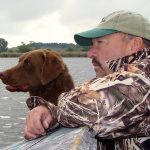By Ryan Eder
Last issue, we explored the AKC Master National event from a macro perspective. We discussed the significant growth of the event since the first one took place in 1991 and how the atmosphere is something special to behold. Certainly, the popularity of our sport has grown overall, and this event plays a significant role in that.
To take an even deeper look, I spoke with two of the top professional trainers and handlers in the hunt test game. Chris Jobman (Flatlander Kennels, Baynard, Nebraska) and Colby Williams (Top Line Retrievers, Hodges, South Carolina) have both attended several Master National events with tremendous success. ast issue, we explored the AKC Master National event from a macro perspective. We discussed the significant growth of the event since the first one took place in 1991 and how the atmosphere is something special to behold. Certainly, the popularity of our sport has grown overall, and this event plays a significant role in that.
The Master National has grown significantly since it began in 1991. To what do you attribute the growth and success of this event?
Chris Jobman: “I believe the main reason why the Master National has gotten so much larger is because the AKC has started recognizing the title of Master National Hunter (MNH) as a “real” title, and it now goes on pedigrees. In my opinion, this was long overdue. I know that’s why Team Flatlander Kennels has started running it and promoting it. It’s a great title to add to a dog’s portfolio. It’s a big deal to own a MNH that is inducted into the Master National Hall of Fame.”
Colby Williams: “I would have to say that the biggest reason for the growth of this event would be because of how inviting Master tests in general are for amateurs to be involved. Obviously, not every amateur out there can take the time off of work to go and run the Master Nationals every fall; but because the weekend events are so popular and people enjoy the environment of the tests and the time spent with friends and their dogs, it has continued to spike the attendance at Master Nationals.
“I think people get hooked on running their dogs in these tests, and once the Master title is achieved, it leaves one asking themselves, “What’s the next chapter to this journey?” That answer more times than not will be to pursue the “plate” that everyone dreams of having for their dogs one day. Simply put, this game is crazy addicting. If someone can’t take the time to run their dog themselves at the National, I feel like they will almost always seek out a pro in their region to do the job for them so their dog can still attend. At the end of the day, if there is no interest from amateurs in the Master National or getting a dog to the Hall of Fame, then none of us as pros would ever be there.”
How significant of a role does the Master National play in your training program?
Jobman: “Honestly, we have always trained to the “Master National standard” — even in the years prior to running it. So it hasn’t really changed our program from a training standpoint. But from a travelstand point, it has changed significantly. We travel a lot now. It’s been fun chasing the “silver plates,” though. The title is worth every mile.”
Williams: “For me as a trainer, the Master National doesn’t change much when it comes to our training program. It is my job to train and prepare these dogs under my care the best possible way that I know. Essentially, we try to go to the field and work every day with the same standard across the board. Whether it is obedience or extremely technical, conceptual work, the standard never changes, which allows you to not be ‘pushing’ on a dog for major issues the month before the big event gets here.”
What challenges arise in your training program when the Master National is one of the major goals each year?
Jobman: “I think one of the challenges would be ‘holding the dogs together’ at the line and not making them “test-wise.” When trying to qualify them to run the MN, they have to run quite a bit, and they can get test-wise and loose. Our MN dogs run multiple venues, so deciding when to run them and doing what’s the best for them is of upmost importance.”
Williams: “A mentor of mine once told me, ‘Son, what you have is what you have; trying to throw the book at them the month before any major event is not the way to handle things.’ You better have the dogs fundamentally sound in their work long before the event gets here. If you were to see me prep for a National, you would probably be surprised at how relaxed our training is.
“I do not believe in pushing on these dogs in a state of panic because we are over-worried and overthinking everything possible. I take things back to the basics. My sets of multiples are relatively spread out and set up for success the month before; and if the test I have set up in training is very tight or technical, then it’s almost always broken down into singles. I’m trying to make my crew as confident as possible in themselves in the weeks before the event, which takes us back to the our key word ‘balance’ that I preach so much.”
From a handler and trainer perspective, what challenges does the Master National pose that are different from a regular weekend hunt test?
Jobman: “From a handler’s perspective, I think trying to get the dogs to maintain a level head and perform at their highest level during the eight-day event. Maintaining their consistency from one series to the next is key.”
Williams: “From a handler’s perspective, I think it is more of a balance problem than anything when leading right up to the event. If anyone has seen me run dogs at the National, they will tell you I’m constantly taking notes on the dogs and flipping back through a small notebook I keep in my back pocket to refresh myself on everything I think is important for me to know about that particular dog. Every dog is different, so every plan of attack is different for me. I believe this is paramount in bringing out the full potential of each dog.
“You know that you are about to go into a six-series event over a week’s span and be more mentally, physically, and emotionally drained than you have ever been before handling dogs. This is where “balance” comes into play. You have to know when to give and when not to, and that’s the million-dollar question we as handlers face every day.”
What are some keys to preparing for this event? What, if anything, changes in your training regimen?
Jobman: “I can tell you one of the biggest factors we face is the use of pheasants. Pheasants and the use of pheasant flyers are a game changer. We don’t see many pheasants at our weekend tests. But they are used on every land series at the Master National. Pheasants can be very challenging for the dogs to smell in taller cover. So we start using nothing but pheasants on our land setups preparing for the Master National.”
Williams:“If there is anything at all that changes for me in training, it would be the use of pheasants;I I usually start training with them hard sixty days before the event. We all know that a hen pheasant placed in the right area can make even the most talented dog look clueless. The Master Nationals use roosters in the event, but I try to order more hens mainly because of the color and the size. My thought process is that if a dog can regularly dig out a hen in cover, then they should have no issue finding a rooster on game day.”
What advice would you give amateurs who have the goal of qualifying for this event and want to be best prepared for success once they get there?
Jobman: “I’d probably tell them to get with a pro or very experienced amateur who runs the event and has had success at the event. Try to train with them as much as possible. A huge advantage I believe is getting in with a good group, and pre-train with them before the event. Pre-training with a great group is invaluable.”
Williams: “My advice to anyone wanting to take on this challenge of running and passing a dog at the Master Nationals would be to stay grounded to your daily routine, and only change your methods when addressing a weakness that you know the dog has. Ask yourself what you think the dog struggles with the most, and go teach the dog how to be successful with that problem in a controlled environment. Train on that issue alone, and then slowly mix it back into normal training as you feel the dog understands how to successfully conquer that task.
“Too many people go to the field and setup a ‘cold test’ and try to nitpick an issue and not actually break things down and spend the time teaching the dog how to do it successfully first in a more controlled environment before taking it back into the field. I love drills to keep my dogs grounded and sharp. The list of drills to run with dogs these days are endless, so study them and handpick a few that will help your dog with a specific issue that seems to be reoccurring. The main thing is, do not overthink or over-stress this process in preparation for the big day. Know your dog and have a game plan set for every scenario you may face, and make sure no matter what to always have fun and love the dog for who he is and just take it all in. It’s an experience you will never forget.”





